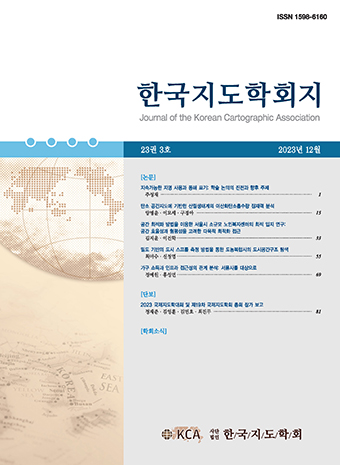Research Article
Abstract
References
Information
The purpose of this study is to analyze the tourist characteristics of tourist attractions and cultural areas of tourists who visited Seoul through spatial analysis of photograph posts posted on Flickr. We collected geotagged data from Flickr between January 1, 2013 and December 31, 2017 in downtown Seoul, and classified all users as tourists and residents. After that, RoA, which is the area visited mainly by tourists, was derived and the tendency of visiting RoA was analyzed. In addition, hotspot areas visited by many tourists in Seoul city were also analyzed. A total of 167,410 data were used in the analysis, and the number of users was 3,921. In order to derive RoA, we derive 11 RoA in Seoul and 12 RoA in Seoul by DBSCAN algorithm. In the whole of Seoul, Jongno, Hongdae, Namsan, Shinchon, Gangnam Station, COEX, Itaewon, Jamsil, Street, War Memorial, RoA was derived from Insadong, Namdaemun, Plaza Mayor, Changgyeonggung, and Hangangganggil. In order to confirm the difference of tourism trends of tourists by culture, we confirmed the tourism trends of Asian, American, and European tourists. In addition, Emerging hotspot (EHSA) was used to confirm the temporal and spatial changes of tourist trends.
본 연구는 플리커에 게시된 사진 게시물에 대한 공간적 분석을 통하여 서울을 방문한 관광객의 주요 관광지와 문화권별 관광 특성을 분석하였다. 서울 시내에 2013년 1월 1일부터 2017년 12월 31일 사이에 플리커의 지오태깅된 데이터를 수집하고, 전체 사용자를 관광객과 거주자로 분류하였다. 이후, 관광객이 주로 방문하는 지역인 RoA를 도출하여 RoA 방문 경향을 분석하였다. 아울러 서울 시내 문화권별 관광객이 많이 방문하는 핫스팟 지역 또한 분석하였다. 분석에 사용된 데이터는 총 167,410건 이였으며, 사용자 수는 3,921명이었다. 이후 RoA를 도출하기 위하여 DBSCAN 알고리즘을 통하여 서울 전체에 11개, 종로 내부에 12개의 RoA를 도출하였다. 서울 전체에 종로, 홍대, 남산, 신촌, 강남역, 코엑스, 이태원, 잠실, 가로수길, 전쟁기념관, 대학로 RoA가 도출되었으며, 종로 내부의 경우에는 경복궁, 명동, 광화문, 동대문, 북촌, 시청, 창덕궁, 인사동, 남대문, 광장시장, 창경궁, 감고당길에서 RoA가 도출되었다. 이후 문화권별 관광객의 관광 경향의 차이를 확인하기 위하여 아시아권, 미주권, 유럽권 관광객의 관광 추이를 확인하였으며, 문화권별로 각각 상이한 핫스팟 지역이 나타난 것을 확인할 수 있었다. 뿐만 아니라 발생핫스팟(EHSA)를 통하여 관광객 추이의 시공간적 변화를 확인하였다.
- 김나연・강영옥・이주윤・김동은・박예림, 2019, “소셜 네트워크 데이터를 활용한 서울방문 관광객의 선호 관광지 시공간 특성 분석,” 서울도시연구, 20(1), 1-15.
- 류시영・유선욱, 2017, “소셜 미디어에 나타난 강원도 관광에 대한 인식 연구,” 관광연구저널, 31(2), 63-81.
- 한국관광공사, 2018, 「2017 외래관광객실태조사 보고서」.
- 박득희・김태구・이계희 , 2016, “소셜 네트워크 분석을 적용한외래 개별관광객의 다(多) 관광지 관광행동에 대한이해,” 호텔경영학연구, 25(4), 201-216.
- 박석희・박상곤, 2005, “수요자 관점에서 본 한국관광통계의 품질평가,”여가관광연구, 8, 1-21.
- 박예림・강영옥・김동은・이주윤・김나연, 2018, “플리커데이타의 텍스트마이닝을 통한 서울방문 외국인 관광객의 서울 이미지 분석,” 한국지형공간정보학회지, 27(1), 13-25.
- 손철・이봉구・김지현・김선준・김민호, 2014, “관광지 내 시공간 이동 행태와 관광객의 특성 영향,” 관광연구논총, 26(2), 3-28.
- 이수진・전유나, 2016, “소셜미디어 빅데이터 분석을 통한 관광 인식 조사,” GRI 연구논총, 18(1), 83-109.
- 이주윤・강영옥・김나연・김동은・박예림, 2018, “궤적데이타 마이닝을 통한 서울방문 관광객의 이동특성분석,” 한국지도학회지, 18(3), 117-129.
- Ester, M., Kriegel, H.P., Sander, J., and Xu, X., 1996, A density-based algorithm for discovering clusters in large spatial databases with noise, Proceedings, 2nd International Conference on Knowledge Discovery and Data Mining(KDD-96), August 2-4, Portland, Oregon, 226-231.
- Getis, A. and Ord, J.K., 1992, The analysis of spatial association by use of distance statistics,
- Geographical analysis, 24(3), 189-206.10.1111/j.1538-4632.1992.tb00261.x
- Hochmair, H.H., 2010, Spatial association of geotagged photos with scenic locations, Proceedings, Geoinformatics Forum, July 6-9, Salzburg, Austria, 91–100.
- Hwang, Y.H., Gretzel, U. and Fesenmaier, D.R., 2006, Multicity trip patterns: Tourists to the United States, Annals of Tourism Research, 33(4), 1057-1078.10.1016/j.annals.2006.04.004
- Kádár, B., 2014, Measuring tourist activities in cities using geotagged photography, Tourism Geographies, 16(1), 88-104.10.1080/14616688.2013.868029
- Kristensson, P.O., Dahlback, N., Anundi, D., Bjornstad, M., Gillberg, H., Haraldsson, J. and Stahl, J., 2009, An evaluation of space time cube representation of spatiotemporal patterns, IEEE Transactions on Visualization and Computer Graphics, 15(4), 696-702.10.1109/TVCG.2008.19419423892
- Mckercher, B. and Lau, G., 2008, Movement patterns of tourists within a destination, Tourism Geographies, 10(3), 355-374.10.1080/14616680802236352
- Silm, S. and Ahas, R., 2014, Ethnic differences in activity spaces: A study of out-of-home nonemployment activities with mobile phone data, Annals of the Association of American Geographers, 104(3), 542-559.10.1080/00045608.2014.892362
- Versichele, M., De Groote, L., Bouuaert, M.C., Neutens, T., Moerman, I., and Van de Weghe, N., 2014, Pattern mining in tourist attraction visits through association rule learning on Bluetooth tracking data: A case study of Ghent, Tourism Management, 44, 67-81.10.1016/j.tourman.2014.02.009
- Wu, C.L. and Carson, D., 2008, Spatial and temporal tourist dispersal analysis in multiple destination travel, Journal of Travel Research, 46(3), 311-317.10.1177/0047287506304046
- Yuan, Y. and Medel, M., 2016, Characterizing international travel behavior from geotagged photos: A case study of flickr, PloS one, 11(5).10.1371/journal.pone.015488527159195PMC4861279
- ESRI, https://pro.arcgis.com.
- Publisher :The Korean Cartographic Association
- Publisher(Ko) :한국지도학회
- Journal Title :Journal of the Korean Cartographic Association
- Journal Title(Ko) :한국지도학회지
- Volume : 19
- No :1
- Pages :35~46
- DOI :https://doi.org/10.16879/jkca.2019.19.1.035



 Journal of the Korean Cartographic Association
Journal of the Korean Cartographic Association





